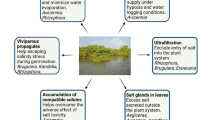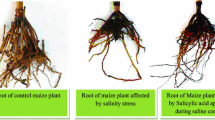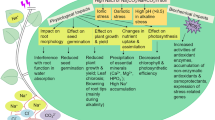Abstract
The effect of the hybrid proline-rich protein (HyPRP) gene EARLI1 on the rate of germination (germinability) of Arabidopsis seeds and seedling growth under low temperature and salt stress conditions was investigated. EARLI1 was induced during germination in embryonic tissues, and was strongly expressed in certain parts of young seedlings. Comparisons of control, overexpressing (OX), and knockout (KO) lines indicated that higher than wild type levels of EARLI1 improved germinability, root elongation, and reduction of sodium accumulation in leaves under salt stress, as well as germinability under low-temperature stress. Abscisic acid (ABA) contents were relatively low after prolonged salt stress, suggesting that EARLI1 has an ABA-independent effect on germinability under these conditions. Overexpression of EARLI1 during germination enhanced the sensitivity of seeds to exogenously applied ABA, suggesting that EARLI1 has an ABA-dependent negative effect on seed germinability under high ABA stress conditions. Well-known stress response marker genes such as COR15a, KIN1, P5SC1, and RD29 were unaffected whereas P5SC2, RD22, or RAB18 were only slightly affected in OX and KO plants. The pleiotropic effects of EARLI1 during stress and an absence of strong regulatory effects on stress marker genes suggest that this HyPRP gene has an auxiliary role for various stress protection responses in Arabidopsis.








Similar content being viewed by others
Abbreviations
- 8CM:
-
Eight-cysteine-motif
- ABA:
-
Abscisic acid
- AZI1 :
-
AZELAIC ACID INDUCED1 (At4g12470)
- EARLI1 :
-
EARLY ARABIDOPSIS ALUMINUM INDUCED1 (At4g12480)
- GA:
-
Gibberellic acid
- GUS:
-
β-Glucuronidase
- HyGRP:
-
Hybrid glycine-rich protein
- HyPRP:
-
Hybrid proline-rich protein
- KO:
-
Knockout
- LTP:
-
Lipid transfer protein
- OX:
-
Overexpressing
- PRD:
-
Proline-rich domain
- qLTG3-1:
-
Quantitative trait locus LOW TEMPERATURE GERMINABILITY 3-1
References
Altschul SF, Madden TL, Schäffer AA, Zhang J, Zhang Z, Miller W, Lipman DJ (1997) Gapped BLAST and PSI-BLAST: a new generation of protein database search programs. Nucleic Acids Res 25:3389–3402
Bentsink L, Koornneef M (2008) Seed dormancy and germination. In: Somerville CR, Meyerowitz EM (eds) The Arabidopsis Book. American Society of Plant Biologists, Rockville
Bilgin DD, DeLucia EH, Clough SJ (2009) A robust plant RNA isolation method suitable for Affymetrix GeneChip analysis and quantitative real-time RT-PCR. Nat Protoc 4:333–340
Bouton S, Viau L, Lelièvre E, Limami AM (2005) A gene encoding a protein with a proline-rich domain (MtPPRD1), revealed by suppressive subtractive hybridization (SSH), is specifically expressed in the Medicago truncatula embryo axis during germination. J Exp Bot 56:825–832
Boyes DC, Zayed AM, Ascenzi R, McCaskill AJ, Hoffman NE, Davis KR, Görlach J (2001) Growth stage-based phenotypic analysis of Arabidopsis: a model for high throughput functional genomics in plants. Plant Cell 13:1499–1510
Bubier J, Schläppi M (2004) Cold induction of EARLI1, a putative lipid transfer protein, is light and calcium-dependent. Plant Cell Environ 27:929–936
Clough S, Bent A (1998) Floral dip: as simplified method for Agrobacterium-mediated transformation of Arabidopsis thaliana. Plant J 16:735–743
Cramer GR (2002) Response of abscisic acid mutants of Arabidopsis to salinity. Funct Plant Biol 29:561–567
Davenport RJ, Muñoz-Mayor A, Jha D, Essah PA, Rus A, Tester M (2007) The Na+ transporter AtHKT1 controls xylem retrieval of Na+ in Arabidopsis. Plant Cell Environ 30:497–507
Dvoráková L, Cvrcková F, Fischer L (2007) Analysis of the hybrid proline-rich protein families from seven plant species suggests rapid diversification of their sequences and expression patterns. BMC Genomics 8:412
Fujino K, Matsuda Y (2010) Genome-wide analysis of genes targeted by qLTG3-1 controlling low-temperature germinability in rice. Plant Mol Biol 72:137–152
Fujino K, Sekiguchi H, Matsuda Y, Sugimoto K, Ono K, Yano M (2008) Molecular identification of a major quantitative trait locus, qLTG3–1, controlling low-temperature germinability in rice. Proc Nat Acad Sci USA 105:12623–12628
Gimeno-Gilles C, Lelièvre E, Viau L, Malik-Ghulam M, Ricoult C, Niebel A, Leduc N, Limami AM (2009) ABA-mediated inhibition of germination is related to the inhibition of genes encoding cell-wall biosynthetic and architecture: modifying enzymes and structural proteins in Medicago truncatula embryo axis. Mol Plant 2:108–119
Holdsworth MJ, Bentsink L, Soppe WJ (2008) Molecular networks regulating Arabidopsis seed maturation, after ripening, dormancy and germination. New Phytol 179:33–54
Hori K, Sugimoto K, Nonoue Y, Ono N, Matsubara K, Yamanouchi U, Abe A, Takeuchi Y, Yano M (2010) Detection of quantitative trait loci controlling pre-harvest sprouting resistance by using backcrossed populations of japonica rice cultivars. Theor Appl Genet 120:1547–1557
Josè-Estanyol M, Ruiz-Avila L, Puigdomènech P (1992) A maize embryo-specific gene encodes a proline-rich and hydrophobic protein. Plant Cell 4:413–423
Josè-Estanyol M, Gomis-Ruth FX, Puigdomènech P (2004) The eight-cysteine motif, a versatile structure in plant proteins. Plant Physiol Biochem 42:355–365
Jung HW, Kim KD, Hwang BK (2005) Identification of pathogen-responsive regions on the promoter of a pepper lipid transfer protein gene (CALTPI) and the enhanced resistance of the CALTPI transgenic Arabidopsis against pathogen and environmental stresses. Planta 221:361–373
Jung HW, Tschaplinski TJ, Wang L, Glazebrook J, Greenberg JT (2009) Priming in systemic plant immunity. Science 324:89–91
Kant S, Kant P, Raveh E, Barak S (2006) Evidence that differential gene expression between the halophyte, Thellungiella halophila, and Arabidopsis thaliana is responsible for higher levels of the compatible osmolyte proline and tight control of Na+ uptake in T. halophila. Plant Cell Environ 29:1220–1234
Kim SG, Park CM (2008) Gibberellic acid-mediated salt signaling in seed germination. Plant Signal Behav 3:877–879
Kim SG, Lee AK, Yoon HK, Park CM (2008) A membrane-bound NAC transcription factor NTL8 regulates gibberellic acid-mediated salt signaling in Arabidopsis seed germination. Plant J 55:77–88
Knight H, Trewavas AJ, Knight MR (1997) Calcium signalling in Arabidopsis thaliana responding to drought and salinity. Plant J 12:1067–1078
Kojima M, Kamada-Nobusada T, Komatsu H, Takei K, Kuroha T, Mizutani M, Ashikari M, Ueguchi-Tanaka M, Matsuoka M, Suzuki K, Sakakibara H (2009) Highly sensitive and high-throughput analysis of plant hormones using MS-probe modification and liquid chromatography–tandem mass spectrometry: an application for hormone profiling in Oryza sativa. Plant Cell Physiol 50:1201–1214
Lee S, Lee EJ, Yang EJ, Lee JE, Park AR, Song WH, Park OK (2004) Proteomic identification of annexins, calcium-dependent membrane binding proteins that mediate osmotic stress and abscisic acid signal transduction in Arabidopsis. Plant Cell 16:1378–1391
Marchler-Bauer A, Anderson JB, Chitsaz F, Derbyshire MK, DeWeese-Scott C, Fong JH, Geer LY, Geer RC, Gonzalez NR, Gwadz M, He S, Hurwitz DI, Jackson JD, Ke Z, Lanczycki CJ, Liebert CA, Liu C, Lu F, Lu S, Marchler GH, Mullokandov M, Song JS, Tasneem A, Thanki N, Yamashita RA, Zhang D, Zhang N, Bryant SH (2009) CDD: specific functional annotation with the Conserved Domain Database. Nucleic Acids Res 37:D205–D210
Müller K, Tintelnot S, Leubner-Metzger G (2006) Endosperm-limited Brassicaceae seed germination: abscisic acid inhibits embryo-induced endosperm weakening of Lepidium sativum (cress) and endosperm rupture of cress and Arabidopsis thaliana. Plant Cell Physiol 47:864–877
Munns R, Tester M (2008) Mechanisms of salinity tolerance. Annu Rev Plant Biol 59:651–681
Nonogaki H, Chen F, Bradford KJ (2007) Mechanisms and genes involved in germination sensu stricto. In: Bradford K, Nonogaki H (eds) Seed development. Dormancy and Germination. Blackwell, Oxford, pp 264–304
Oh E, Kim J, Park E, Kim JI, Kang C, Choi G (2004) PIL5, a phytochrome-interacting basic helix-loop-helix protein, is a key negative regulator of seed germination in Arabidopsis thaliana. Plant Cell 16:3045–3058
Ren Z, Aheng Z, Chinnusamy V, Zhu J, Cui X, Ilda K, Zhu J-K (2010) RAS1, a quantitative trait locus for salt tolerance and ABA sensitivity in Arabidopsis. Proc Nat Acad Sci USA 107:5669–5674
Taji T, Seki M, Satou M, Skurai T, Kobayashi M, Ishiyama K, Narusaka Y, Narusaka M, Zhu JK, Shinozaki K (2004) Comparative genomics in salt tolerance between Arabidopsis and Arabidopsis related halophyte salt cress using Arabidopsis microarray. Plant Physiol 135:1697–1709
Weyman PD, Pan Z, Feng Q, Gilchrist DG, Bostock RM (2006) DEA1, a circadian- and cold-regulated tomato gene, protects yeast cells from freezing death. Plant Mol Biol 62:547–559
Wilkosz R, Schläppi M (2000) A gene expression screen identifies EARLI1 as a novel vernalization-responsive gene in Arabidopsis thaliana. Plant Mol Biol 44:777–787
Xu ZY, Zhang X, Schläppi M, Xu, ZQ (2011) Cold-induced expression of AZI1 and its function in improvement of freezing tolerance of Arabidopsis thaliana and Saccharomyces cerevisiae. J Plant Physiol. doi:10.1016/j.jplph.2011.01.023
Yamaguchi S, Smith MW, Brown RG, Kamiya Y, Sun T (1998) Phytochrome regulation and differential expression of gibberellin 3b-hydroxylase genes in germinating Arabidopsis seeds. Plant Cell 10:2115–2126
Yamauchi Y, Ogawa M, Kuwahara A, Hanada A, Kamiya Y, Yamaguchi S (2004) Activation of gibberellin biosynthesis and response pathways by low temperature during imbibition of Arabidopsis thaliana seeds. Plant Cell 16:367–378
Zhang Y, Schläppi M (2007) Cold responsive EARLI1 type HyPRPs improve freezing survival of yeast and form higher order protein complexes in plants. Planta 227:233–243
Acknowledgments
We thank Dr. Richard Wilkosz for helping with the GUS constructs. We strongly appreciate the expertise of Drs. Jinfang Chu, Xiaohong Sun, and Cunyu Yan (National Centre for Plant Gene Research, Institute of Genetics and Developmental Biology, Chinese Academy of Sciences, Beijing, China) in determining the ABA contents of Arabidopsis seedlings. We are very grateful to Dr. Chengcai Chu (Institute of Genetics and Developmental Biology, Chinese Academy of Sciences) and members of his laboratory for technical and material assistance regarding the qPCR and hormone detection analyses. This work was supported in part by a grant from the US Department of Agriculture (96-35301-3867), the National Natural Science Foundation of China (30870194), the Provincial Key Laboratory Research Project of the Education Department of Shaanxi Province (08JZ70, 2010JS090), the Development Project of Science and Technology Research of Shaanxi Province (the Program for Tackling Key Problems, 2010K16-04-01) and the Postgraduate Innovation Research Project of Northwest University (09YSY38).
Author information
Authors and Affiliations
Corresponding author
Electronic supplementary material
Below is the link to the electronic supplementary material.
Rights and permissions
About this article
Cite this article
Xu, D., Huang, X., Xu, ZQ. et al. The HyPRP gene EARLI1 has an auxiliary role for germinability and early seedling development under low temperature and salt stress conditions in Arabidopsis thaliana . Planta 234, 565–577 (2011). https://doi.org/10.1007/s00425-011-1425-9
Received:
Accepted:
Published:
Issue Date:
DOI: https://doi.org/10.1007/s00425-011-1425-9




